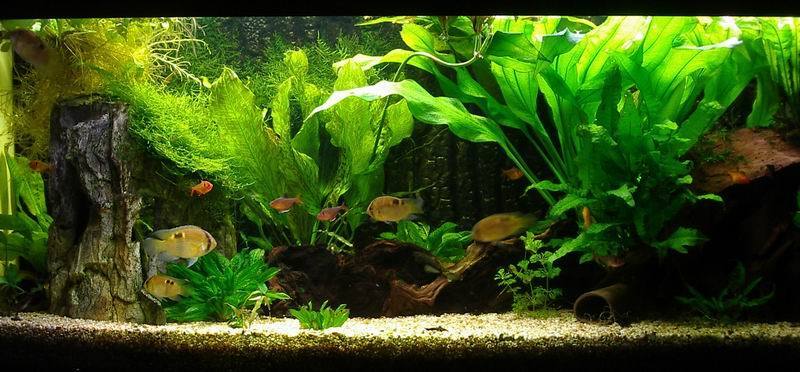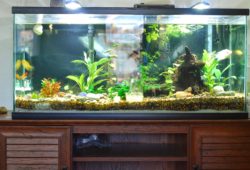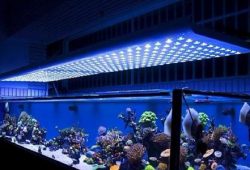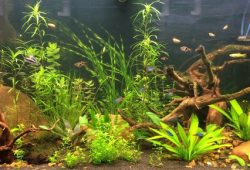Silent revolution
Silent revolution. Over the past decade or so, there has been a quiet revolution in marine systems. The recognition that biological filtration was the key to keeping marine fish in closed systems made the modern home marine aquarium possible, bringing reef aquaria that no-one would have believed feasible into our living rooms.
It has even made it possible to keep some tricky fish. Yet although natural systems seem quite new, they date back to the birth of the modern aquarium in the early 19th century.

Contents
What’s natural?
So what is a natural aquarium system? This is a good question as ordinary biological filters make use of natural processes. However, they do share a number of features.
One common factor is that they all use material (living rock or sand) collected from the ocean. But in a natural system, biological filtration is performed by algae and bacteria growing on sand or rock with water circulated over them.
The benefits of nature
Basic natural systems, such as a simplified Berlin-style fish-only system, can maintain very high water quality while remaining very simple. The fact that a complete cycle of nitrification and denitrification can be achieved in the living rock and the sandbed means that little technology is required.
Apart from heating and lighting, all the system needs is a pump or powerhead for circulation and a skimmer – and if you stock lightly with fish, the skimmer is optional.
It provides a huge area for bacteria, and its depth allows a steep oxygen gradient to develop that favours the growth of bacteria that nitrify aerobically (in the surface layers) and those that denitrify anaerobically (deep within the bed).
It also encourages a wide range of microfauna which reduce the nutrient load on the bacterial biofilter.
Deep sandbeds are tricky to accommodate within the display tank (they take up a lot of space), but can easily be accommodated in a sump. Skimmers and live rock are usually used, but relatively little of the latter is needed.
Jaubert system
The plenum or Jaubert system was developed by coral researcher
Dr Jean Jaubert and his team at the Monaco aquarium. In it, the sandbed sits on a platform raised off the base of the tank with a space (the plenum) underneath.
There is much speculation as to how plenum systems work, but I suspect that its presence enables the oxygen levels in the water diffusing through the sand to be decreased just enough to facilitate denitrification, and no more.
Originally the system was semi-open and had a steady input of new water replacing the old, somewhat like a continuous slow water change. The original systems did not use skimmers, but many home plenum systems do. Living rock is usually included, but as with any system where the sandbed is expected to do a lot of the biofilter work, relatively little is needed.
Mix and match
Relatively few enthusiasts use these systems exactly as they were developed, usually adopting various elements and combining them.
All the above systems work, and the common elements – live rock, strong water movement and some way of decreasing levels of dissolved organics (a skimmer or a macroalgae-filled sump) – are the important contributors. Other components may have advantages in particular circumstances.
Fish and reefkeepers like nothing better than to argue about filtration systems, but outside specialised applications, the bells and whistles don’t make all that much difference.
Setting up is simple, too. Cured living rock is a ready-matured biofilter, so there’s no need for the traditional maturation process.
In a natural system, biological wastes are cycled in much the same way as in the wild. Within the tank are much more complex food webs and nutrient cycles than are found in a “sterile”, traditional marine tank. This makes it easier to maintain water conditions the way that marine fish and inverts like them, and keeps the physical environment of the residents closer to that in the wild, which should make them feel (as well as look) more at home.
Natural systems are easy to maintain. And with no filters, there’s no filter cleaning. Syphoning out detritus often isn’t necessary as this forms a food source for microfauna and is removed by good skimming and strong water movement. Natural systems also seem to be
less demanding in terms of regular partial water changes than traditional systems.
Once living rock is put into an aquarium, it will rapidly be colonised by both microfauna and algae. These provide free, live, natural
food for fish and corals.
Including a refugium is even better. Chances of success with some tricky fish species – mandarins and their relatives, some Angels and even a few tang species – are much better in a tank with plenty of living rock and its supply of natural food.
Natural systems can’t be beaten on looks, from reef aquaria with stunning corals to fish-only tanks with a backdrop of gnarled rock encrusted with pink and purple coralline algae.
Live rock and sand
All natural systems use live (living) rock. This is essentially rubble collected from shallow water, usually as a result of storm damage to reefs. It is colonised by a wide range of animals, algae and bacteria.
Live rock is made up of the fossilised calcareous skeletons of corals and coralline algae, modified by the tunnelling actions of molluscs, sponges and so on. This has a large surface area that can be colonised by bacteria.
The outer layers of the rock are aerobic, but the level of oxygen decreases further inside. So live rock provides a biological filter that not only converts ammonia to nitrite and then nitrate in aerobic conditions, but also provides denitrification within its anoxic zones, making a complete nitrogen cycle possible.
Some natural systems use living rock as the primary biological filter. Others use it as a source of both bacteria and other beneficial organisms to “seed” the system.
Sand is also widely used in natural aquarium systems. Sand (coral sand, aragonite, oolite) provides large surface areas for bacterial colonisation. By making the right type of sandbed, both nitrification and dentrification can occur.
An advantage sand has over live rock is that it provides a vast area for bacteria. Sand also provides a home to a range of small burrowing organisms, from tiny brittlestars to worms, molluscs and crustaceans.
It is also worth mentioning live sand, which is colonised with a variety of organisms. This can be aquacultured and supplied colonised with bacteria ready to work as a biological filter. It is bought in sealed bags or tubs and has a long shelf life.
You could also buy live sand collected from the wild, which is colonised by a much wider range of organisms including worms, crustaceans, protozoans and other micro-organisms. You can buy an aquacultured version where the diversity of organisms present is less than that of wild-collected sand, but is much more than just bacteria.
Vigorous water movement is essential for effective biological filtration in such systems. Getting the correct oxygen gradients for both nitrification and denitrification, without creating highly anaerobic conditions, requires a strong flow of well-oxygenated water over the surfaces of living rock or sand beds.
The key piece of technology in most natural systems is the skimmer. This dates back to the early development of the Berlin system, and since then most aquaria based on Berlin-type techniques have used ever more powerful skimmers. Debate however rages as to whether over-efficient skimming is deleterious as a result of the removal of planktonic micro-organisms.
Which method for you?
The Berlin system
This was the original natural system which first became popular with European and American fishkeepers. Even today, modified versions of Berlin methodology are probably the most popular of natural systems.
The key elements are living rock, vigorous water circulation and skimmers. Other elements such as the use of metal halide lights and dosing with kalkwasser to maintain calcium levels are considered integral.
Ecosystem
The relatively new Ecosystem method is somewhat different. It is more reliant on algae and does not use a skimmer.
Ecosystem tanks use living rock and sand in the display tank, but this is supplemented by a refugium or sump which supports a heavy growth of Caulerpa macroalgae. The Caulerpa is grown in a special substrate called Miracle Mud, and is lit 24 hours a day.
Skimmers are not used because they are thought to remove trace elements, planktonic life and beneficial bacteria – the macroalgae takes the place of the skimmer in removing organic pollutants.
Deep sandbeds
This is just what it says – a bed more than 10cm/4″, and possibly up to 30cm/12″ deep. Putting a sandbed this deep in a traditional marine system would be potentially disastrous as highly anaerobic conditions would develop, leading to the production of highly toxic hydrogen sulphide.
But things are different in natural systems. Strong water movement permeates the bed, while burrowing creatures create a network of tunnels that allow water to penetrate without becoming too anaerobic.
It provides a huge area for bacteria, and its depth allows a steep oxygen gradient to develop that favours the growth of bacteria that nitrify aerobically (in the surface layers) and those that denitrify anaerobically (deep within the bed).
It also encourages a wide range of microfauna which reduce the nutrient load on the bacterial biofilter.
Deep sandbeds are tricky to accommodate within the display tank (they take up a lot of space), but can easily be accommodated in a sump. Skimmers and live rock are usually used, but relatively little of the latter is needed.
Mix and match
Relatively few enthusiasts use these systems exactly as they were developed, usually adopting various elements and combining them.
All the above systems work, and the common elements – live rock, strong water movement and some way of decreasing levels of dissolved organics (a skimmer or a macroalgae-filled sump) – are the important contributors. Other components may have advantages in particular circumstances.
Fish and reefkeepers like nothing better than to argue about filtration systems, but outside specialised applications, the bells and whistles don’t make all that much difference.
Algae, friend or foe?
Many marine fishkeepers see algae primarily as a nuisance, though some see their value as tank decor. But in natural systems, algae play an important role in biological filtration.
Algae take up nitrogen- and phosphorus-containing compounds
and use them as nutrients. They seem to prefer ammonia, and in doing so, they decrease the quantity that has to be processed by the bacterial part of the biological filter.
Some systems have an obvious role for algae (eg the ecosystem method), but they are important in all live rock-based systems. The coralline algae loved by reeftank enthusiasts play the same role as macroalgae or filamentous algae, if less efficiently.
Minute workers
Microfauna is a general term for the small animals associated with live rock. They proliferate, to some degree, in natural systems. They include crustaceans (amphipods, copepods and isopods), worms, molluscs, small starfish and brittlestars.
Microfauna have a very important role to play in the natural aquarium by creating complex food webs. This ensures that any nutrient inputs to the tank (eg fish food) are used efficiently so that only minimal levels end up in the water.
Refugia explained
A refugium is an area of the tank that is separated from the main display area in order to prevent predation of microfauna and grazing of algae. It may be as simple as a fenced-off area, or could be a separate tank into which water is pumped before draining back into the display area – this prevents plankton being destroyed by pumps or skimmers.
Refugia can help keep populations of microfauna up despite predation from fish in the rest of the tank. At the same time, they provide a rich source of live food.
Algae in the refugium is protected from grazing, and this may help it play its part in biological filtration more effectively. Not all natural systems use refugia, but they are becoming more popular.
This article was first published in the March 2004 issue of Practical Fishkeeping magazine.



